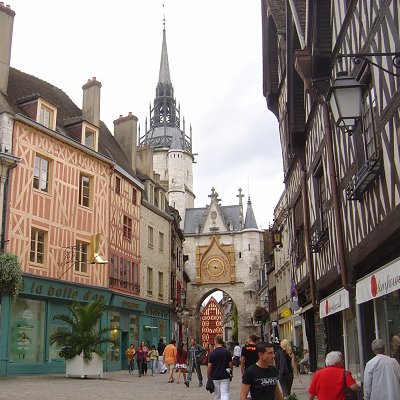
Like us on Facebook
PLACE NAMES


 
|
|
Auxerre
|

|
|
Auxerre is the capital of the Yonne department and the fourth-largest city in Burgundy. Auxerre's population today is about 39,000; the metropolitan area comprises roughly 92,000 inhabitants. Residents of Auxerre are referred to as Auxerrois.
Auxerre is a commercial and industrial centre, with industries including food production, woodworking and batteries. It is also noted for its production of Burgundy wine, including world-famous Chablis. In 1995 Auxerre was named "Town of Art and History".
Auxerre was a flourishing Gallo-Roman centre, then called Autissiodorum, through which passed one of the main roads of the area, the Via Agrippa (1st century AD) which crossed the Yonne River (Gallo-Roman Icauna) here. In the third century it became the seat of a bishop and a provincial capital of the Roman Empire. In the 5th century it received a Cathedral. In the late 11th-early 12th century the existing communities were included inside a new line of walls built by the feudal counts of Auxerre.
Bourgeois activities accompanied the traditional land and wine cultivations starting from the twelfth century, and Auxerre developed into a commune with a Town Hall of its own. The Burgundian city, which became part of France under King Louis XI, suffered during the Hundred Years' War and the Wars of Religion. In 1567 it was captured by the Huguenots, and many of the Catholic edifices were damaged. The medieval ramparts were demolished in the 18th century.
In the 19th century numerous heavy infrastructures were built, including a railway station, a psychiatric hospital and the courts, and new quarters were developed on the right bank of the Yonne.
Up until recently, Auxerre was one of the most prosperous cities in the country.
Main sights
- Cathedral of St. Étienne (11th-16th centuries). In Gothic style, it is renowned for its three doorways with remarkable bas-reliefs. The stained glass windows in the choir and the apsidal chapel are among the finest in France. The 11th century crypt houses the remains of the former Romanesque cathedral.
- Abbey of Saint-Germain, existing from the ninth century. The crypt has some of the most ancient mural paintings in France, and houses the tomb of the bishops of Auxerre. Also interesting are the chapter room (12th century), the cellar (14th century) and the cloister (seventeenth century).
- The Clock tower, located in the Old Town
- The church of St. Pierre en Vallée (17th-18th centuries), established over a 6th-century abbey. In the style of late Gothic architecture, it has a tower similar to that of the cathedral. Portions of the decorations and inner chapels were financed by local winegrowers.
- Church of St. Eusèbe, founded in the 7th century. The nave was rebuilt in the 13th century, while the tower is in Romanesque style.
 Feel free to Email me any additions or corrections Feel free to Email me any additions or corrections
LINKS AVAILABLE TO YOUR SITE
| | |





